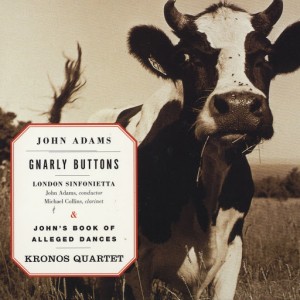John Adams, “John’s Book of Alleged Dances” and “Gnarly Buttons”
By admin_mike In
John Adams, John’s Book of Alleged Dances and Gnarly Buttons, released 1995 by Elektra Nonesuch Records
John’s Book of Alleged Dances (1994), performed by the Kronos Quartet
1. Judah to Ocean
2. Toot Nipple
3. Dogjam
4. Pavane: She’s So Fine
5. Rag the Bone
6. Habanera
7. Stubble Crotchet
8. Hammer & Chisel
9. Alligator Escalator
10. Ständchen
11. Judah to Ocean (reprise)
Gnarly Buttons (1996), performed by the London Sinfonietta; John Adams, conductor; Michael Collins, clarinet
1. The Perilous Shore
2. Hoe-down (Mad Cow)
3. Put Your Loving Arms Around Me
___
While minimalism traces its origin to Satie and Ravel and was made an aesthetic position by La Monte Young and Terry Riley, it came to fruition with Steve Reich, Philip Glass, and John Adams in the mid-late ’60s. In large part a revolution against the hypercomplex, aggressively dissonant (and often wicked ugly) music in vogue in academic circles (exemplified by Boulez and Stockhausen), that era of minimalism is characterised by extreme use of repetition (of both motivic and harmonic material), the reestablishment of continuous pulse as an integral part of music, and a highly austere approach to form and timbre. All three members of the Second Minimalist School have since developed minimalism into something greater: Reich’s most interesting projects these days are about integrating music, speech, and video; Glass is intensively exploring the inverse relationship between quality and popularity; and Adams is melding the rhythmic and harmonic approach of minimalism with the grand narrative sweep, rich instrumental textures, and emotional resonance of Romanticism.
John’s Book of Alleged Dances is, as advertised, a suite of nonexistent dances for string quartet, with some backed by rhythm tracks made on a prepared piano. I think of it as what would happen if Bartok encountered Tom Waits, taking the robust, rough cheer of American folk music and developing it in the classical idiom while still preserving its rustic character — and there are some more elegant, stately movements in there that also have a lot of charm. It’s great fun[1], with a lot of bounce, physical verve, complex and pleasing interlocking rhythms, and virtuosic fiddling. Listening to it always makes me smile.
***
Gnarly Buttons, a clarinet concerto for chamber orchestra with extras[2], is a more dynamic and varied piece. “The Perilous Shore”, somewhat melancholy and anguished, begins with a desperately somber melody based on a shape-note hymn, played by solo clarinet; the line provides the musical material for the entire movement. The orchestra hesitantly takes up the melody, and the movement is built out of the orchestra and clarinet riffing back and forth on the opening melody, growing and developing until being interrupted by a banjo solo, after which the orchestra wanders around confused before the clarinet takes control again. But the orchestra fragments again and fades away, and The Perilous Shore ends ominously, with some light rhythmic screeching on the violins, bowing behind the bridge.
“Hoe-Down (Mad Cow)” is a scherzo of sorts, a stilted, clumsy dance that takes some of its material from the accompanying figures in the first movement. It’s cute and energetic, with surprising and amusing moments, in what I guess is a simple (A | B | A+B) structure.
The last movement, “Put Your Loving Arms Around Me”, again begins with the clarinet, playing a sweet, tender melody over a simple chordal accompaniment in the piano. As the rest of the orchestra joins the piano in the accompaniment, the harmony underneath the clarinet changes, recalling the desperation and ominous feel of the first movement; the tension builds, culminating in a chaotic free-for-all, out of which emerges the simple clarinet/piano duet of the opening, and they fade out to end Gnarly Buttons.
Despite the scope of Gnarly Buttons, I like the Alleged Dances better. They’re tighter and more focused, and more fun to listen to. Gnarly Buttons is an excellently crafted piece, and I enjoy listening to it, but it’s not a piece I need to hear that often. I suppose, also, I’m not a big fan of Romanticism, and it’s a larger part of GB than JBoAD, which are much more emotionally neutral[3].
___
(1) It occurs to me that ‘delightful’ rather than ‘fun’ would be a better word; and that at one of the many worthwhile things that art can do is inspire delight in its audience, something I think many artists have forgotten.
(2) One player doubling on guitar, mandolin, and banjo; and two synthesizers.
(3) I recall an exchange:
UNKNOWN: How can you not like Beethoven’s Ninth? Don’t you like being moved?
JOHN CAGE: I like being moved. I don’t like being pushed.


No Comment
Sorry, the comment form is closed at this time.